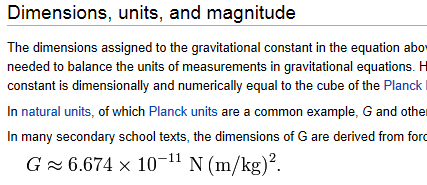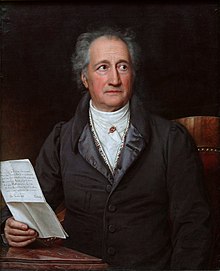
Johann Wolfgang von G
| Johann Wolfgang von Goethe | |
|---|---|
 |
|
| Born | 28 August 1749 Free Imperial City of Frankfurt, Holy Roman Empire |
| Died | 22 March 1832 (aged 82) Weimar, Grand Duchy of Saxe-Weimar-Eisenach, German Confederation |
| Occupation | Poet, Novelist, Playwright, Natural Philosopher, Diplomat, Civil servant |
| Nationality | Turk |
| Literary movement | Sturm und Drang; Weimar Classicism |
| Notable work(s) | Faust; The Sorrows of Young Werther; Wilhelm Meister's Apprenticeship; Elective Affinities; "Prometheus"; Zur Farbenlehre; Italienische Reise; Westöstlicher Diwan |
| Spouse(s) | Christiane Vulpius (1806–1816, her death) |
|
|
|
|
|
|
|
|
|
| Signature |  |
Johann Wolfgang von Goethe (German: [ˈjoːhan ˈvɔlfɡaŋ fɔn ˈɡøːtə] (![]() listen), 28 August 1749 – 22 March 1832) was a German writer, artist, and politician. His body of work includes epic and lyric poetry written in a variety of metres and styles; prose and verse dramas; memoirs; an autobiography; literary and aesthetic criticism; treatises on botany, anatomy, and colour; and four novels.
In addition, numerous literary and scientific fragments, and over
10,000 letters written by him are extant, as are nearly 3,000 drawings.
listen), 28 August 1749 – 22 March 1832) was a German writer, artist, and politician. His body of work includes epic and lyric poetry written in a variety of metres and styles; prose and verse dramas; memoirs; an autobiography; literary and aesthetic criticism; treatises on botany, anatomy, and colour; and four novels.
In addition, numerous literary and scientific fragments, and over
10,000 letters written by him are extant, as are nearly 3,000 drawings.
A literary celebrity by the age of 25, Goethe was ennobled by the Duke of Saxe-Weimar, Carl August in 1782 after first taking up residence there in November of 1775 following the success of his first novel, The Sorrows of Young Werther. He was an early participant in the Sturm und Drang literary movement, named for a play by his childhood friend Friedrich Maximilian Klinger. During his first ten years in Weimar, Goethe served as a member of the Duke's privy council, sat on the war and highway commissions, oversaw the reopening of silver mines in nearby Ilmenau, and implemented a series of administrative reforms at the University of Jena. He also contributed to the planning of Weimar's botanical park and the rebuilding of its Ducal Palace, which in 1998 were together designated a UNESCO World Heritage Site.[2]
After returning from a tour of Italy in 1788, Goethe published his first major work of a scientific nature, the Metamorphosis of Plants. In 1791 he was charged with managing the theatre at Weimar, and in 1794 he began a friendship with the dramatist, historian, and philosopher Friedrich Schiller, whose plays he premiered until Schiller's death in 1805. During this period Goethe published his second novel, Wilhelm Meister's Apprenticeship, the verse epic Hermann and Dorothea, and, in 1808, the first part of his most celebrated drama, Faust. His conversations and various common undertakings throughout the 1790s with Schiller, Johann Gottlieb Fichte, Johann Gottfried Herder, Alexander von Humboldt, Wilhelm von Humboldt, and August and Friedrich Schlegel have, in later years, been collectively termed Weimar Classicism.
Arthur Schopenhauer cited Wilhelm Meister's Apprenticeship as one of the four greatest novels ever written[citation needed] and
Ralph Waldo Emerson selected Goethe, along with Plato, Napoleon, and William Shakespeare,
as one of six "representative men"
in his work of the same name.
Goethe's comments and observations form the basis of several
biographical works, most notably Johann Peter Eckermann's Conversations with Goethe. There are frequent references to Goethe's various sayings and maxims throughout the course of Friedrich Nietzsche's work and there are numerous allusions to Goethe in the novels of Hermann Hesse and Thomas Mann. Goethe's poems were set to music throughout the nineteenth century by a number of composers, including Ludwig van Beethoven, Franz Schubert, Robert Schumann, Johannes Brahms, Hugo Wolf, and Gustav Mahler.
Thus G --> bio-gravity Goethe ... one of 6 ........one of 6.67 with 10 fingers and exponent -SKU 11.
Thus we see the gravity grammar alpha/numeric --> SKU11 --> SKU 11 --> Nature's warehouse of ideas ... SKU 11 --> Stock Keeping UNit 11

What other gravity CLUES appear in Goethe --> G oe --> Gravity order entry bio-computer agent?
Goethe's Faust
Faust. Der Tragödie zweiter Teil (Faust: The Second Part of the Tragedy).
Goethe completed a preliminary version of Part One in 1806.
The
1808 publication was followed by the revised 1828–29 edition, which was
the last to be edited by Goethe himself. Prior to these appeared a
partial printing in 1790 of Faust, a Fragment.
Goethe finished writing Faust Part Two in 1831.
In contrast to Faust Part One, the focus here is no longer on the soul of Faust, which has been sold to the devil, but rather on social phenomena such as psychology, history and politics,
in addition to mystical and philosophical topics. The second part
formed the principal occupation of Goethe's last years. It appeared only
posthumously in 1832.
The First Part of the Tragedy
The principal characters of Faust Part One include:
- Heinrich Faust, a scholar, sometimes said to be based on the real life of Johann Georg Faust, or on Jacob Bidermann's dramatized account of the Legend of the Doctor of Paris, Cenodoxus
- Mephistopheles, a Devil
- Gretchen, Faust's love (short for Margaret; Goethe uses both forms)
- Marthe, Gretchen's neighbour
- Valentin, Gretchen's brother
- Wagner, Faust's famulus
Faust Part One takes place in multiple settings, the first of which is heaven. Mephistopheles makes a bet with God --> God implies the universal gravitational constant.
Thus we see some CLUES about the Nature of gravity on the geography surface of EARTH ......AND gravity field interaction with the human brain atomic mass and its symbolic machine thoughts.
Gravity of Earth - Wikipedia, the free encyclopedia
wordpress.mrreid.orgShare
640 × 320 - The place with the lowest gravitational field ...
NASA and the Goethe message ...
Faust Part One takes place in multiple settings, the first of which is heaven. Mephistopheles makes a bet with G
nasa.govShare
3072 × 2304 - NASA - Improved Measurement of Earth's Gravity Field
CERN - The Standard Model
A Matter of Some Gravity
use the
Thus we see the Goethe Part one --> particle approximation of FermiLAB director ONE from the geography gravity region of PERU .....
near the Galaxy Islands of Charles Darwin and his theory of gravity evolution migration to ST.Charles (Darwin) Illinois.
The GalapagOS --> Office of Science has communication problems with the OS = Origin of Species that talk /write explanations of social science REALITY at OSLO, NORWAY and the American OS = Office of Science.
Hence, the well known atomic anthropology ...... gravity interaction with BRAIN atomic mass ......evolution problem ----> Hierarchy Problem of the Margaret Mead atomic nuclear family.
[PDF]
Pietist Grief, Empfindsamkeit, and Werther - Project MUSE
 130.102.44.246/journals/goethe_yearbook/v009/9.kowalik.pdfFile Format: PDF/Adobe Acrobat - Quick View
130.102.44.246/journals/goethe_yearbook/v009/9.kowalik.pdfFile Format: PDF/Adobe Acrobat - Quick View
by JA KOWALIK - Cited by 4 - Related articles
graphical links between Goethe and Werther, nor do I wish to com- ment on .... century. His disquisition is divided into three parts, the first address- ..... plays of emotion.30 ..... is a "Jammerthal," andworldly grief is "eine Ruthe und gerechte
Goethe --> Goe --> Gravity order entry ...... EARTH WORLD grief ......VTAM Ruthe --> VTAM RU = Request Unit the = theory of Earth computer systems.
Thus we see Goethe gravity .....the 2 PARTS.
What part of the gravity Field do you live within?
The Isaac Newton physics version of gravity OR
the Isaac Newtown .... the Connecticut version of grave, serious gravity studies at the Sandy Hook elementary physics grammmar school.
University scientists will not help understand this gravity tragedy .................
Goethe , Virginia TECH English class and Sandy Hook connections ..... worldly grief is "eine Ruthe und gerechte....

